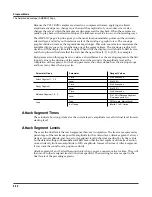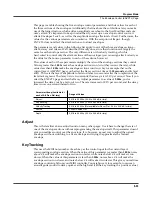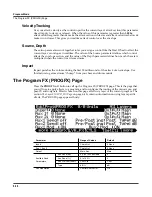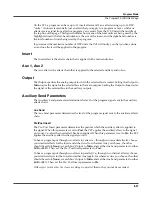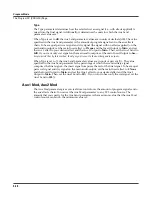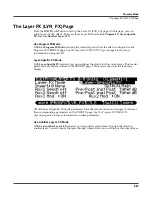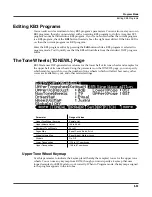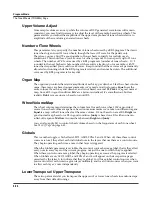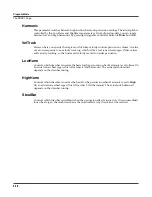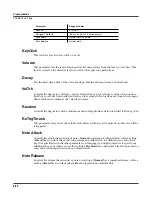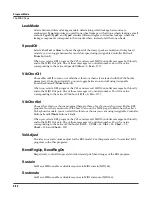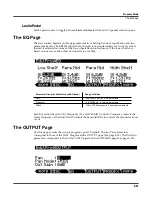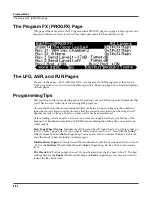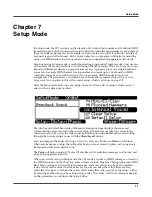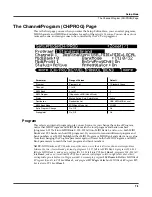
6-54
Program Mode
The Tone Wheels (TONEWL) Page
Upper Volume Adjust
Since sample volumes can vary, while the volume of DSP-generated waveforms will remain
consistent, you may find it necessary to adjust the level of the sample-based tone wheels. This
parameter lets you adjust the amplitude of the upper (sample-based) tone wheels relative to
amplitude of the waveform-generated tone wheels.
Number of Tone Wheels
This parameter lets you specify the number of tone wheels used by a KB3 program. The classic
tone wheel organs used 91 tone wheels, though the lowest 12 were for the pedals only.
Therefore, you may find 79 a good number of tone wheels to specify for realistic organ
emulations. This would leave you 88 voices for other programs. You can specify up to 91 tone
wheels. The number of PC3 voices used by a KB3 program is (number of tone 1) / 2,
rounded to the next highest whole number if the result is a fraction. So, for example, with 79
tone wheels specified you would use 40 voices. Keep in mind that these voices are permanently
allocated and running while the KB3 program is selected, and cannot be stolen. The additional
voice used by KB3 programs is for keyclick.
Organ Map
The organ map controls the relative amplitude of each key, per drawbar. Like the wheel volume
maps, these maps are based on measurements we’ve made on actual organs.
Equal
uses the
same volume for each key and drawbar, and is not based on a real B3.
Peck’s
is a good normal
map, from a B3 in good condition.
Eric’s
is a bit more idealized; it’s smoothed out, but less
realistic.
Bob’s
is more uneven, based on an old B3.
Wheel Volume Map
The wheel volume map determines the volume level for each tone wheel. We’ve provided
several tone wheel volume maps here, based on measurements we’ve taken on different organs.
Equal
is a map with all tone wheels at the same volume. It’s not based on a real B3.
Bright
is a
good normal map, based on a B3 in good condition.
Junky
is based on a B3 with an uneven,
rolled-off response.
Mellow
is somewhere between
Bright
and
Junky
.
You can also apply EQ to control wheel volumes based on the frequencies of each tone wheel.
See
The EQ Page
on page 6-63.
Globals
This is another toggle, which affects LFO2, ASR2, FUNs 2 and 4. When off, these three control
sources are local; they affect each individual note in the layers that use them as a control source.
They begin operating each time a note in that layer is triggered.
When the Globals parameter is set to
On
, these control sources become global, that is they affect
every note in every layer of the current program, not just the one to which they’re applied.
When these control sources are global, they begin operating as soon as the program is selected.
When Globals are on, LFO2, ASR2, and FUNs 2 and 4 will appear on their respective pages
preceded by the letter G to indicate that they’re global. You’ll use global control sources when
you want to affect each note in a given layer uniformly, and local control sources when you want
to affect each layer’s note independently.
Lower Transpose / Upper Transpose
These two parameters let you transpose the upper and/or lower tone wheels in semitone steps
away from their default tunings.
Summary of Contents for PC3
Page 24: ...1 6 Introduction Options ...
Page 50: ...4 4 The Operating Modes Using the Modes ...
Page 174: ...7 54 Setup Mode The Utility Soft Buttons ...
Page 178: ...8 4 Quick Access Mode Making Your Own QA Banks ...
Page 204: ...9 26 Effects Mono Algorithms ...
Page 266: ...A 2 MIDI Implementation Chart ...
Page 308: ...Index x ...



